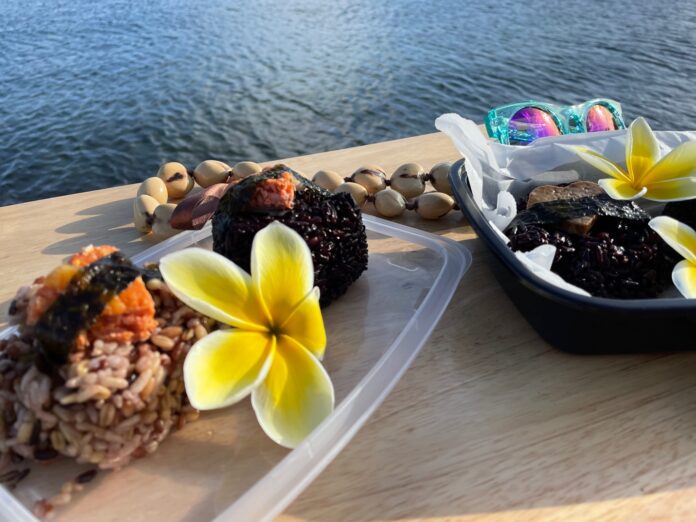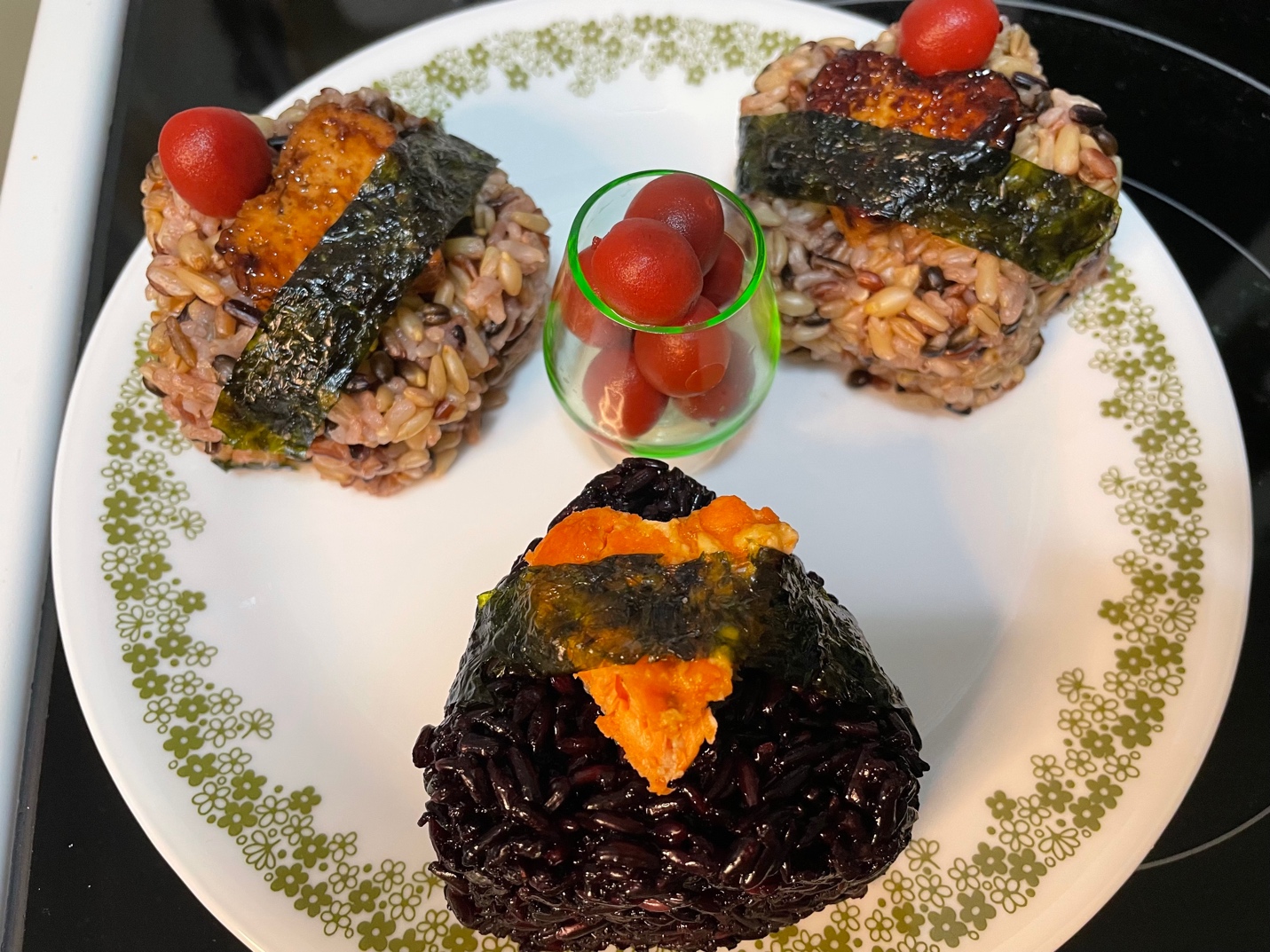
By Gini Mayehara
Ten years ago, if you had asked New Yorkers where to go for the best poke bowl, they would have looked at you quizzically. Since then, and largely thanks to the efforts of pioneering Hawaiʻin restaurateur Roy Yamaguchi, the foods of the 50th State have burst on the scene.
One Hawaiʻin dish in particular that has captured the imagination and the taste buds of foodies is the musubi, even though most probably couldn’t tell you what exactly it is. In this post, I will explore that question and provide a pair of recipes for this popular dish.
The Musubi’s Origins
The musubi originated in Japan. Its literal meaning is “something tied together.” The first mention of a musubi-type food in Japan was during the Nara Period (710-794 AD), when rice was quickly formed into small balls and eaten by hand. They were quick to prepare, simple to make, and convenient to eat.
The style of the musubi changed during the Kamakura (1185-1333) and Edo (1603-1868) Periods. The rice was lightly salted, and nori was used to wrap and flavor the rice balls. Piquant foods like ume (salted, pickled plums), salty salmon, and konbu (edible kelp) were placed in the center of the musubi. This intensified the flavor and preserved the musubi.
Hawai’i’s Connection to the Musubi
In a 2017 article Krystal Kakimoto notes that the Japanese immigrants who worked in the plantation fields of Hawai’i helped create the Spam musubi. During World War II, the military brought Spam to Hawaiʻi. Food was scarce during the war. Hence, the Japanese used this luncheon meat to pair with rice balls. The first type of Spam musubi included layers of steamed white rice pressed into baking pans topped with thin slices of Spam. They resembled a cake, which was sliced into squares and explicitly served during dinner.
According to AirtoHawaii the inventor of the Spam musubi was a Mrs. Mitsuko Kaneshiro, who first made it for her children before selling them out of a local drug store in Honolulu during the 1980s.
AirtoHawaii (2022) introduces Mrs. Mitsuko Kaneshiro, a woman who made the SPAM® musubi very popular in Hawai’i. She initially began making them for her children. Further, she started selling them at a local drug store in Honolulu during the 1980s to earn an income, where they became a top seller.
Today the people of Hawaiʻi, regardless of race, feel a nostalgic connection to the musubi. Personally, it brings me back to my childhood when my late paternal grandmother, granduncles, and grandaunt made this delicious snack. We would drive to the park or the beach during the late afternoon and eat them there while enjoying the outdoors. Another memory I have is bringing both Spam and plain musubis for lunch during school field trips. They were the most convenient food item to make that wouldn’t spoil without refrigeration.
Today, the musubi is a versatile, fast, and practical snack with various toppings, garnishes, sauces, and shapes to satisfy individual preferences. They’re even made with healthier rice options, such as brown and multi-grain rice.
Below are two original recipes for musubi, one for vegans. For these recipes, I chose Korean black rice and Japanese multi-grain rice because they’re healthier options than plain white rice. These grains also add a different mouthfeel and flavor to the traditional musubi. I love a challenge, and I love to be unique. Note that both of these ingredients can be obtained at Kalustyan’s, at 123 Lexington Avenue.
The Gen-Ji-Mai multi-grain rice contains a multitude of grains, including the Gen-Ji-Ma Japanese whole-grain brown rice and 11 other grains: hull-less barley, rye berries, Jasmine brown rice, red rice, Calmat brown rice, black barley, long-grain red rice, black rice, whole oats, brown sweet, and wild rice.
Korean black rice is also referred to as “forbidden rice.” The color of the cereal isn’t black, per se, but a deep, dark purple color. This grain contains the antioxidant anthocyanin, which is included in blueberries and açai berries.

VEGAN TERIYAKI “SPAM” MUSUBI
Ingredients/Equipment
- 2 cups Korean black rice
- 3 Tbsp rice vinegar
- 1 tsp organic raw cane sugar
- 1 container extra firm organic tofu, cut into rectangles (or, if desired, into unique shapes using a cookie cutter)
- ¼ cup soy sauce
- ⅛ cup water
- ¼ cup vegan stir fry sauce
- ¼ tsp onion powder
- ⅛ tsp white pepper
- ½ tsp liquid smoke
- ¼ tsp paprika
- 1 tsp sesame oil (for pan-frying)
- Nori, cut into strips
Directions
- Wash rice until the water runs clear. Then cook and set aside.
- Briefly heat raw cane sugar over low heat to melt it. Off heat, add the vinegar. Then gently fold in the cooked rice. Set aside.
- Cut the firm tofu into rectangles or shapes. Pat with paper towels to remove excess liquid.
- In a bowl, make the teriyaki sauce by combining the soy sauce, water, vegan stir fry sauce, onion powder, white pepper, liquid smoke, and paprika.
- Marinate the tofu in the teriyaki sauce for 30 minutes.
- Coat a frying pan with sesame oil. Pan-fry the tofu over low-medium heat.
- Flip when the tofu takes on a golden brown color. Repeat on the other side. Remove from the heat.
- Insert the rice into the musubi molds. Make sure the rice is tightly packed in the mold before turning out the compacted rice.
- Place the vegan “spam” on top of the rice. Place the nori strips horizontally, wrapping the musubi.
- Serve immediately with ume (optional).
Yield: 4-5 servings
HAWAIIAN BBQ SALMON MUSUBI
Ingredients
- 2 cups Japanese multi-grain rice
- 2 cups water
- 3 Tbsp rice vinegar
- 1 tsp organic raw cane sugar
- Korean nori, cut into strips
- 1 wild salmon fillet
- ½ cup raw honey
- ½ cup bottled BBQ sauce
- ⅛ cup soy sauce
- 8 oz. crushed pineapple, drained
- 1 tsp ginger powder
- Avocado oil for pan-frying
Directions
- Wash rice until the water runs clear. Then cook and set aside.
- Briefly heat raw cane sugar on low heat to melt it. Off heat, add the vinegar. Then gently fold in the cooked rice. Set aside.
- Gently fold sauce with the cooked rice. Set aside.
- In a large bowl, combine honey, bottled BBQ sauce, soy sauce, crushed pineapple, and ginger powder.
- Marinate the salmon in the above for one hour.
- Coat a frying pan with avocado oil. Pan-fry the salmon over medium-high heat for about 4 to 5 minutes on each side. Remove from the heat and allow the fish to cool briefly.
- Insert the rice into the musubi molds. Make sure the rice is tightly packed in the mold before turning out the compacted rice.
- Place the cookie cutter onto the fish and cut out into the desired shape, or cut them into squares or rectangles, depending on the shape of the rice ball.
- Place the shaped fish on top of the rice. Place the nori strips horizontally, wrapping the musubi.
- Serve immediately with ume (optional).
Yield: 4-5 servings
Gini Mayehara, a native of Hawaiʻi, is graduating from the Auguste Escoffier School of Culinary Arts. She is creator of the blog FooDNisTaSoul.
See also…
The Latest Restaurant to Be Bitten by the Vegan Bug Is noreetuh
















